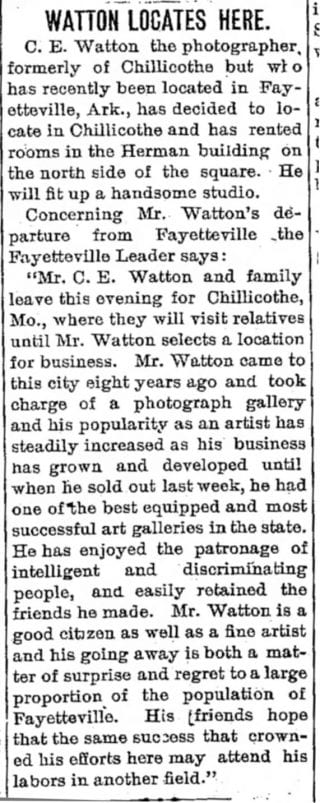The University of Arkansas (then known as Arkansas Industrial University) welcomed its first students in 1872, but it wasn’t until 1897 that students published their first yearbook. Among the key contributors to that first yearbook, the Cardinal, was C. E. Watton, who was not actually a student, but a local professional photographer.
Ads run by C. E. Watton in the 1897, 1898, and 1900 Cardinal yearbooks.
Charles Edward Watton was born August 24, 1870, in Shelbyville, Illinois, to Granville D. and Emeline Watton. In his early twenties, C. E. Watton ran the “Big Red” grocery store in Shelbyville, but around 1895, he moved to Fayetteville, where over the next eight years he advanced from serving as the protégé of photographer Sarah Jessie Young (whose name still adorns the building on the Square—then called the Bogarth Building—where her second-floor studio, and later Watton’s, stood) to succeeding her as a well-respected proprietor in his own right. Watton served as a photographer for several early Cardinals, and his handiwork in these volumes will soon be fully available online as part of a University Libraries’ project to digitize the full run of Cardinal and Razorback yearbooks. Watton was also involved on campus in other ways, from taking group photographs for campus organizations to serving as an advisor of sorts to the Camera Fiends club.

While living in Fayetteville, Watton started both his photography career and his family. He married Lillie Belle England on July 12, 1899, and the couple had their first son, Max, the next year. In 1903, the family moved to Chillicothe, Missouri, which was notable for being the home of both sliced bread and, perhaps more pertinently, Lillie Belle’s family. The Chillicothe Constitution-Tribune, announcing his arrival, posed it as Chillicothe’s gain and Fayetteville’s loss, quoting the Fayetteville Leader that his departure was “a matter of surprise and regret to a large proportion, of the population living in Fayetteville.” In Chillicothe, he initially worked for J.B. Huffman while scouting out possibilities for his own studio, which he opened on May 28, 1903. Back in Fayetteville, 1903’s Cardinal, for the first time, had no advertisement for Watton—although there was one for his successor, W. H. Albertson, who advertised that he retained all of Watton’s negatives and was able to offer photoduplicates upon request.
In the mid-1940s, Watton passed his photography business down to his son, Max, and enjoyed a brief retirement before passing away February 24, 1949. For some fifty years, he’d been photographing families, university students, high school students, baseball teams, company offices, power plants, and local events. He had served as President of Northwest Missouri Photographer’s Club and as a Missouri commissioner for the Missouri Valley Photographers Association. Today his photographs appear in archival collections throughout Arkansas and Missouri, including at the Fayetteville Public Library and in Special Collections’ own holdings, from the Cardinal yearbooks to cabinet card portraits in the Albert Homer Purdue Papers (MC 214) and University photographs in the Winston L. Winters Papers (MC 1304).






